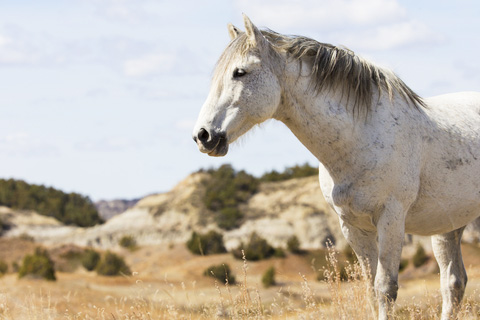To read part one first, click here.
In his Reno Gazette article, Craig Downer makes the case that the wild horse is truly a wild, native species. As is widely acknowledged by the scientific community, the modern horse originated in North America around two million years ago. The ancestors of the horse, in North America, go back much farther than that. At least until ten to twelve thousand years ago – horses roamed the lands where they are found today in North America. As Craig Downer points out, “considerable evidence indicates that horses never totally died out, although they diminished, along with many other species at the close of the last Ice Age.” Many disbursed, going across the Bering Strait to Asia and from there they spread out across the world.
He writes, “Horses are not mere machines; they are living beings who have arisen out of myriad past generations predominately in the wild! They possess an amazing wisdom, aka instincts, that gives them adaptive abilities that harmoniously fit into a variety of ecosystems, which they enhance.”
He explains that populations of wild horses are much needed to restore the health of ecosystems. Because they are semi-nomadic, they do not wear down the vegetation and the soil in the same way that cows do. Wild horses disperse seeds from a greater variety of plants, and they enrich the soil, allowing vegetation to grow back, followed by the return of bird, mammal, reptile, and amphibian species. As a native species, wild horses belong on the land as an essential, re-vitalizing part of the ecosystem.
 In another article, The Wild Horse is Native to North America, by Ross MacPhee, PhD, Curator – Division of Vertebrate Zoology, American Museum of Natural History, New York, NY, published by The Cloud Foundation, the author writes, “It needs to be more widely understood that the horse’s status as a native North American species is beyond serious question.”
In another article, The Wild Horse is Native to North America, by Ross MacPhee, PhD, Curator – Division of Vertebrate Zoology, American Museum of Natural History, New York, NY, published by The Cloud Foundation, the author writes, “It needs to be more widely understood that the horse’s status as a native North American species is beyond serious question.”
According to Ross MacPhee, a native species is one that evolved in a particular geographic location, and there is no doubt that the wild horse evolved in North America. During the Pleistocene, the wild horse lived in North America from two and a half million to around 10,000 years ago. This is supported by both fossil and DNA evidence. The horse is an American species and is not native to any other continent.
From a scientific viewpoint, it matters not at all that the horse spread to other continents and was domesticated along the way. In the evolutionary time scale this is only a blip on the radar. The wild horse is a native species that has returned to his place of origin. Ross MacPhee concludes, “Reintroduction of horses to North America 500 years ago is, biologically, a non-event: horses were merely returned to part of their former native range, where they have since prospered because ecologically they never left.”
Craig Downer ends his article in the Reno Gazette Journal with a call for profound change, to restore the rightful place of the American wild horse, and to share the land with these “magnificent and highly evolved beings.”
Copyright © Sharon St Joan, 2015
Top photo: Jaime Jackson / Wikimedia Commons / “This file is licensed under the Creative Commons Attribution-Share Alike 3.0 Unported license.” / Free roaming wild horses in Utah.
Second photo: © Mikael Males | Dreamstime.com
Third photo: Hiraeth99 / Wikimedia Commons / “This file is licensed under the Creative Commons Attribution-Share Alike 4.0 International license.” / Wild horses in Alberta, Canada.
To find Craig Downer’s book, The Wild Horse Conspiracy, on Amazon, click here.
To read Craig Downer’s article in the Reno Gazette Journal, click here.
To read Ross MacPhee’s article on the Cloud Foundation website, click here.







4 Comments
Sharon, thanks so much for this article. Here is an article that makes a totally believable case that populations of horses existed in North America prior to 1492, but coming back from Asia: <http://marcopoloinseattle.com/Documents/Indian%20Horses%20before%20Colmbus.html> There is also a good article on the Animal Welfare Institute website <https://awionline.org/content/wild-horses-native-north-american-wildlife> which makes a very definitive case that the North American wild horse of today is exactly the same genetically as the North American wild horse that evolved here – whether it went extinct or not being irrelevant to the fact that it is a NATIVE North American species. I think we must begin to start proclaiming the wild horses as being both NATIVE and ENDANGERED. Why the mainstream enviro/conservationists continue to believe that the wild horses are non-native/invasive and as such must be exterminated is something that continues to elude me. Their tune just so happens to be the one the federal government prefers to dance to, as government agencies cater to the wishes of western ranchers to whom the wild horses are competitors for forage that might “grow beef” for sale to American consumers or for export – poor cattle fattened on public lands that supposedly belong to all of us.
The first article above is really fascinating and explains a great deal about the history of the wild horses! – though I wasn’t able to get the link to work to the second one. Thanks so much, Kim!
SPEAK TRUTH…YES, THANK YOU SHARON ST. JOAN FOR EDUCATING US ALL ABOUT OUR NATIVE WILD HORSES!!! WE NEED TO RISE UP AND PROTECT THEM NOW, BEFORE THEY ARE COMPLETELY DESTROYED. THEY ARE SO IMPORTANT TO A HEALTHY ECO SYSTEM AND THEY ARE THE MOST MAJESTICALLY BEINGS I HAVE EVER WITNESSED ON THIS EARTH!!!
BE THEIR VOICE!! TINA WOOTEN